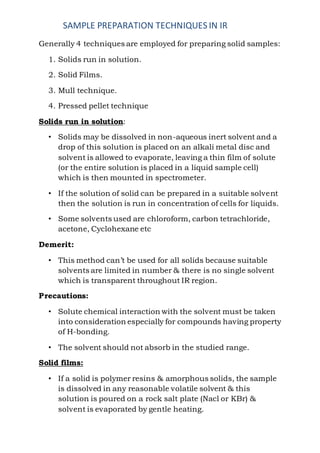
Sampling techniques for ir
- 1. SAMPLE PREPARATION TECHNIQUES IN IR Generally 4 techniques are employed for preparing solid samples: 1. Solids run in solution. 2. Solid Films. 3. Mull technique. 4. Pressed pellet technique Solids run in solution: • Solids may be dissolved in non-aqueous inert solvent and a drop of this solution is placed on an alkali metal disc and solvent is allowed to evaporate, leaving a thin film of solute (or the entire solution is placed in a liquid sample cell) which is then mounted in spectrometer. • If the solution of solid can be prepared in a suitable solvent then the solution is run in concentration of cells for liquids. • Some solvents used are chloroform, carbon tetrachloride, acetone, Cyclohexane etc Demerit: • This method can’t be used for all solids because suitable solvents are limited in number & there is no single solvent which is transparent throughout IR region. Precautions: • Solute chemical interaction with the solvent must be taken into consideration especially for compounds having property of H-bonding. • The solvent should not absorb in the studied range. Solid films: • If a solid is polymer resins & amorphous solids, the sample is dissolved in any reasonable volatile solvent & this solution is poured on a rock salt plate (Nacl or KBr) & solvent is evaporated by gentle heating.
- 2. SAMPLE PREPARATION TECHNIQUES IN IR • If solid is non-crystalline, a thin homogenous film is deposited on the plate which can be mounted and scanned directly. • Sometimes polymers can be “hot pressed” onto plates. Merit and Demerit: This method is useful for rapid qualitative analysis but becomes useless for carrying out quantitative analysis Mull technique: • In this technique a small quantity of sample is thoroughly ground in a clean mortar until the powder is very fine. • After grinding, the mulling agent (mineral oil or Nujol) is introduced in small quantities just sufficient to take up the powder (mixture approximates the consistency of a toothpaste). • The mixture is then transferred to the mull plates & the plates are squeezed together to adjust the thickness of the sample between IR transmitting windows. • This is then mounted in a path of IR beam and the spectrum is run. Demerit: • Although Nujol is transparent throughout IR region, yet it has a disadvantage that it has absorption maxima at 2915, 1462, 1376 & 719 cm-1. • So when IR spectrum of solid sample is taken in Nujol mull, absorption bands of solid sample that happen to coincide with the absorption bands of the Nujol mull will be hidden (but others will be clearly seen in IR spectrum) and then interferes with the absorption of the sample. • This method is good for qualitative analysis but not for quantitative analysis
- 3. SAMPLE PREPARATION TECHNIQUES IN IR Pressed pellet technique: • In this technique a small amount of finely ground solid sample is intimately mixed with about 100 times its weight of powdered Potassium bromide, in a vibrating ball mill. • This finely ground mixture is then pressed under very high pressure (25000 p sig) in evacuable die or minipress to form a small pellet (about 1-2 mm thick and 1cm in diameter). • The resulting pellet is transparent to IR radiation and is run as such. • The powder (KBr + sample) is introduced in between the 2 bolts and the upper screw A is tightened until the powder is compressed to a thin disc. • After compressing the sample bolts A & A1 are removed and a steel cylinder with pellet inside it is placed in path of the beam of IR spectrometer and a blank KBr pellet of identical thickness is kept in the path of reference beam Advantages of this technique over mull technique • The use of KBr eliminates the problem of bands which appear in IR spectrum due to the mulling agent as in this case no such bands appear. • KBr pellets can be stored for longer periods of time. • As concentration of the sample can be suitably adjusted in pellets, it can be used for quantitative analysis. • The resolution of spectrum in KBr is superior to that obtained with mulls Demerits: • It always has a band at 3450 cm-1, from –OH group of moisture present in the sample. • The high pressure involved during the formation of pellets may bring about polymorphic changes in crystallinity in the
- 4. SAMPLE PREPARATION TECHNIQUES IN IR samples, (Especially inorganic complexes) which may cause complications in IR spectrum. In some cases, even substitution of the ligand by bromide may be possible in inorganic complexes. • This method is not successful for some polymers which are difficult to grind with KBr. Sampling for gases: Small size particles hence the cells are large. •10 cm to 1m long •Multiple reflections can be used to make the effective path length as long as 40 cm •Lacks sensitivity Sampling for liquids: Liquid samples taken. •Put it into rectangular cells of KBr, NaCl etc. •I R spectra obtained. •Sample thickness … such that transmittance lies between 15 – 20 % i.e., 0.015 – 0.05 mm in thickness. •For double beam, matched cells are generally employed •One cell contains sample while other has solvent used in sample. •Matched cells should be of same thickness, protect from moisture.
